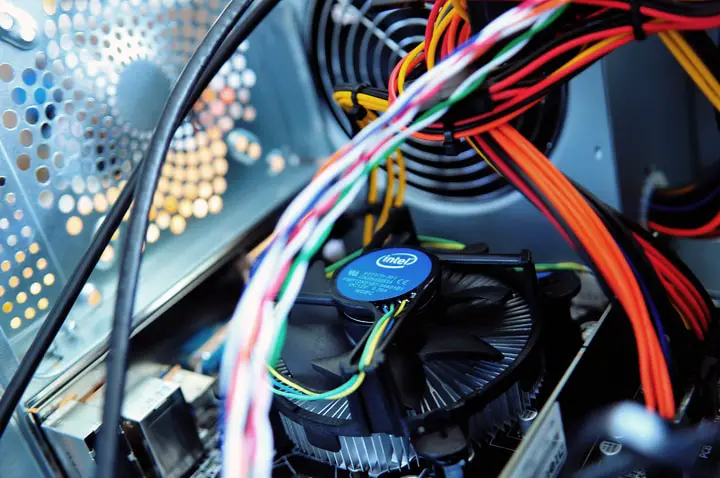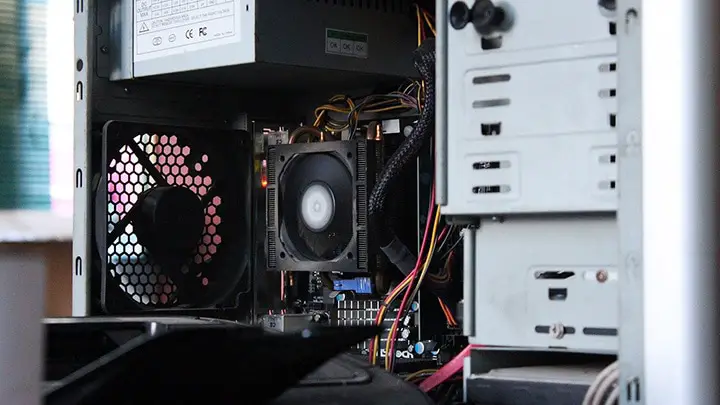
Overclocking is an effective way to improve your CPU’s performance. You don't have to spend anything on hardware or software upgrades. Instead, you simply set the right conditions for your CPU to run at a clock frequency that's higher than intended.
In this blog post, I'm going to walk you through how to overclock CPUs.
Contents
We’re going to rely on a few software tools to help us monitor the internal conditions of the CPU. There are native tools that do the same thing but I find that these are much easier to work with.
Don’t worry, they’re all free:
Technically, you can overclock any CPU by simply raising its base clock. However, certain processors don't respond very well to being overclocked and can end up with a lot of stability issues.
On the other hand, some CPUs directly support overclocking because they have unlocked multipliers. Without getting into too much detail, this means that you can safely change the CPU frequency.
If you've got an Intel CPU, then all you need to do is look at the model name. If there's a 'K' or an 'X' in it, then it can be overclocked. If you'd rather be more certain, then you can simply check out this list of unlocked Intel processors from the official website.
If you've got an AMD processor, you have nothing to worry about. This is because all modern Ryzen processors are unlocked. If you've got a processor that's several generations old, then you may want to do a quick online search to see if it's overclock-friendly.
If you’ve confirmed that your CPU canbe overclocked then let’s move on to the next steps.
Overclocking can raise your CPU's temperature quite significantly. Hence you'll want to monitor the temperature to make sure it doesn't get out of hand to the extent that it starts damaging your CPU and other components.
There are two ways to check your processor's temperature:
1) Using the native BIOS
2) Using a third-party tool
In our case, we're going to rely on the aforementioned Core Temp software because it's much simpler to use. So go ahead and install it on your computer.
Once you launch the application, you'll see an interface with lots of technical information displayed. Don't worry if you don't understand most of these terms, because we're only going to focus on what part of it.
Take a look at the temperature readings section and you'll see all of the core temperatures (labeled from Core#0 - Core#3 or more, depending on the number of cores your CPU has). On the right, you'll see two columns: 'Min' and 'Max', denoting the minimum and maximum temperatures recorded for each core.
Generally, a temperature between 40°C and 65°C is considered safe for typical workloads. For more processor-intensive tasks, the temperature can spike up to the 80s.
The internal temperature shouldn't go beyond 90 degrees for an extended period. Otherwise, the silicon parts in your component can degrade much quicker, reducing the overall lifespan of your CPU.

There are several ways to keep your CPU from overheating, including:
Before you increase the clock speed, make sure that your CPU is stable under the default clock speed. This will help you avoid major problems down the line.
If you haven't already, make sure to download and install Prime95. Follow the setup instructions on the website so you end up downloading the zip folder that corresponds with your operating system. Running a stress test is pretty simple with Prime95. Just load it up and click on the test tab. The default settings should be enough for a balanced test so you don't need to mess with anything there.
Leave the test running for a couple of hours and check for any errors. If you don’t get any errors then you’re good to go.
How do you check whether overclocking has had an impact on your CPU's performance? You need to first run a benchmarking test to understand what your CPU's baseline performance is. For this, we're going to be using Cinebench which can simulate a workload.
The thing about Cinebench scores is that they're linear. This means that if your CPU scores 2000, it's twice as quick as a CPU with a score of 1000. You'll want to make a note of your current Cinebench score so you can compare this with the overclocked performance.
Once you've set up temperature monitoring, run a stress test, and gather what your CPU's baseline performance is, it's time to show you how to safely overclock CPUs. The most reliable way to do it is through the BIOS.
The BIOS is a simple interface that allows you to configure your system at the most basic level. It contains low-level drivers that give you control over the computer's hardware.
To access the BIOS, you need to restart the computer. While it restarting, press either the F2, F10 or Delete key repeatedly. This will redirect you to the BIOS controls. Here, you will be prompted to press a certain key or a combination of keys to give you access to the setup.
Once you're inside the BIOS, you can typically find the overclock settings inside the Advanced CPU Core Settings tab. Depending on the model of your motherboard, the exact wording might differ. Certain motherboards may provide an automatic overclock setting which boosts the CPU's performance at very safe levels. However, if you want to squeeze as much power out of your CPU as possible, then you're better off overclocking manually.

The first step towards a manual overclock is increasing the multiplier, which in turn will allow you to raise the base clock speed. You must increase it gradually, preferably by pressing the '+' key on your keyboard, to avoid stressing out your CPU too much at once.
It's up to you how many cores you want to overclock on your CPU. However keep in mind that the more cores you decide to push, the hotter it’s going to get. Hence, every time you take the speed up a notch, make sure to go back to Core Temp and check the temperature readings. Make sure that things aren't getting way too hot.
Once you've increased the multiplier (each increased step corresponds to a 100MHz increase in base clock speed) to the desired level, save your settings, and restart your PC. Afterward, perform another stress test and a benchmark test to see how your CPU now in terms of stability and performance.
If you're not happy with the increase in performance and you can't seem to raise the multiplier any further without making things unstable, there's something else you can do. Load up the BIOS again and find the CPU voltage setting. This can take on several other names including CPU Vcore, CPU VCCIN, Dynamic Vcore...etc.
Increasing the CPU voltage gives you more headroom for overclocking. This means that you can increase the multipliers a bit more without causing further instability. When you're upping the voltage, take care to do it very slowly so as not to stress your processor too hard.
By tweaking both the multiplier and CPU voltage back and forth, you'll eventually find the maximum overclocked speed. Make sure you check your temperature and perform a stress test and Cinbench test every time you make a change in either. If you find that the temperature is spiking too hard, I highly recommend that you upgrade your cooling system before you attempt to overclock again.
And that’s it for our guide on how to overclock a processor! Pat yourself on the back for successfully following through!
Sometimes your PC may not boot up after you overclock. This most likely means you've overclocked way too much and your CPU just isn't getting enough voltage to support it. But don't worry, the fix is quite simple.
You can simply reset the BIOs by pressing the clear/reset CMOS button on your mother. This causes it to revert to the default values. Afterward, simply try again but stick to the last multiplier and CPU voltage settings that were stable.
If this doesn't work, you can try removing the motherboard's battery, waiting ten seconds, and putting it back in. However, you should always read through your motherboard's manual before attempting to do this.
You should overclock your CPU only if you need extra power. For instance, if you’re not getting a fast enough frame rate when you’re gaming, you can overclock your CPU for a smoother performance. Video editors and 3D modeling artists also overclock their PCs whenever they need to reduce render times.
Overclocking places a lot of stress on your CPU but it typically won't fry any internal components, contrary to popular belief. If the clock frequency is set higher than what your PC can handle, it'll simply just reboot or hit you with a black or blue screen. In the case of the latter, you can simply reset the BIOS.
That being said, continuous overclocking does take a toll on the CPU, reducing its lifespan. However, a lot of people don't stick with the same CPU for a decade so this isn't much of a big deal.
Hence, overall, overclocking is pretty safe. Just make sure you're cooling system is a fairly good one to avoid reboots and black/blue screens.
There are a couple of different ones that I've had personal experience with. For instance, the Intel overclocking tool Extreme Tuning Utility (XTU) provides an easy interface for monitoring CPU utilization, temperature, and frequency. It even has a manual tuning tab that gives you direct access to the multiplier and CPU voltage.
In addition to this Intel overclocking software, you also get tools like Afterburner from MSI that not only work for your CPU but your GPU as well.
Related Posts:
Overclocking can help you achieve better performance without having to buy new hardware. Hence, it’s a great money saver if done right.
As you can see, overclocking is quite a time-consuming and delicate process. While you gradually push the CPU’s clock speed, you have to make sure that the internal temperature is kept in check and that you’re not stressing out the system too hard.
That being said, it’s still a safe procedure and you shouldn’t have any trouble if you follow the instructions.
